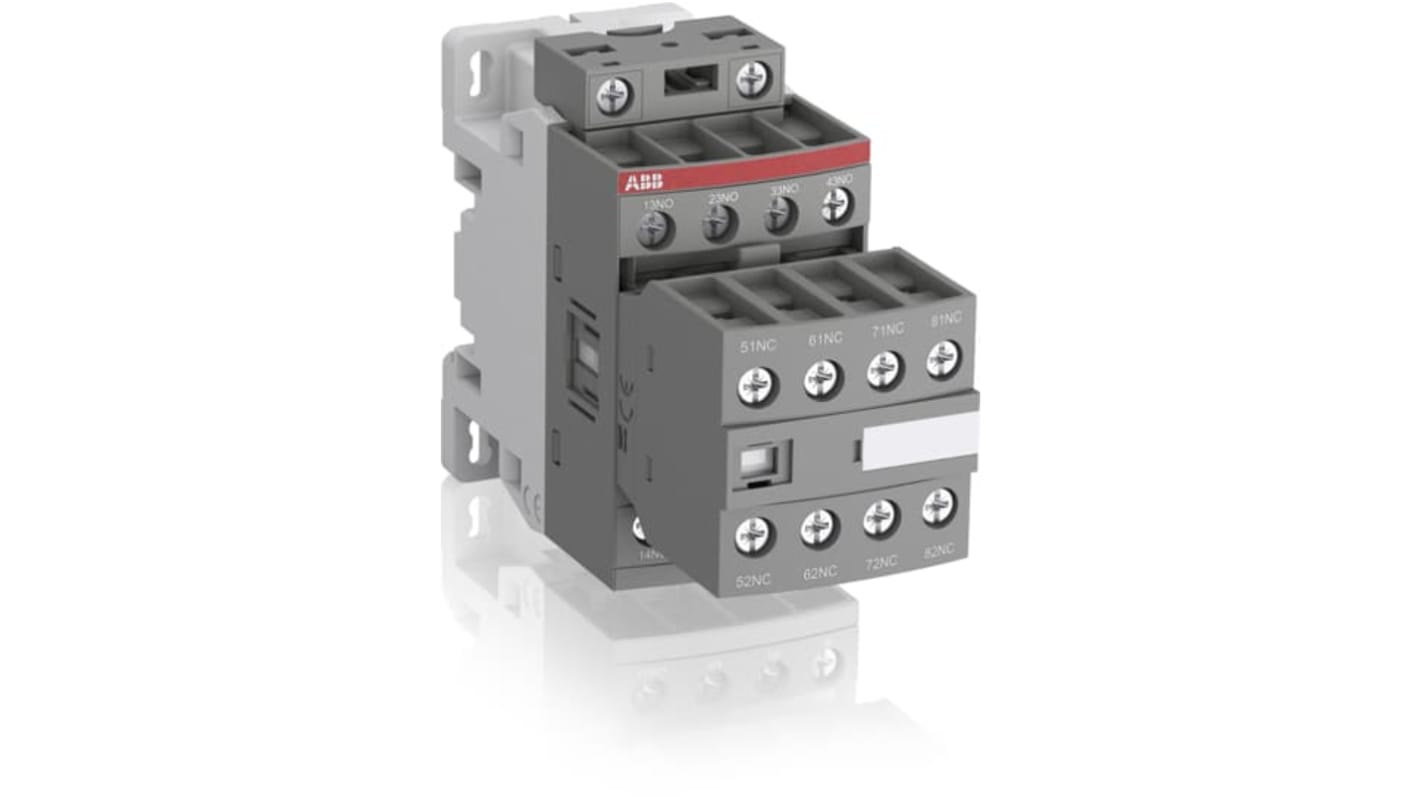ABB NFZ Contactor Relay, 690 V Coil, 8-Pole, 6 A, 4NO/4NC
- RS Stock No.:
- 237-4856
- Mfr. Part No.:
- 1SBH136001R2044
- Brand:
- ABB

Subtotal (1 unit)*
£114.90
(exc. VAT)
£137.88
(inc. VAT)
FREE delivery for orders over £50.00
Temporarily out of stock
- Shipping from 06 January 2026
Need more? Click ‘Check delivery dates’ to find extra stock and lead times.
Units | Per unit |
|---|---|
| 1 + | £114.90 |
*price indicative
- RS Stock No.:
- 237-4856
- Mfr. Part No.:
- 1SBH136001R2044
- Brand:
- ABB
Specifications
Technical Reference
Legislation and Compliance
Product Details
Find similar products by selecting one or more attributes.
Select all | Attribute | Value |
|---|---|---|
| Brand | ABB | |
| Coil Voltage | 690 V | |
| Number of Poles | 8 | |
| Contact Current Rating | 6 A | |
| Series | NFZ | |
| Normal State Configuration | 4NO/4NC | |
| Auxiliary Contact Configuration | 4NO + 4NC | |
| Number Of Auxiliary Contacts | 8 | |
| Terminal Type | Screw | |
| Length | 110.5mm | |
| Width | 45mm | |
| Depth | 110.5mm | |
| Minimum Operating Temperature | -40°C | |
| Mounting Style | DIN Rail | |
| Control Voltage | 20 V dc | |
| Maximum Operating Temperature | +70°C | |
| Pole and Throw Configuration | 8P | |
| Select all | ||
|---|---|---|
Brand ABB | ||
Coil Voltage 690 V | ||
Number of Poles 8 | ||
Contact Current Rating 6 A | ||
Series NFZ | ||
Normal State Configuration 4NO/4NC | ||
Auxiliary Contact Configuration 4NO + 4NC | ||
Number Of Auxiliary Contacts 8 | ||
Terminal Type Screw | ||
Length 110.5mm | ||
Width 45mm | ||
Depth 110.5mm | ||
Minimum Operating Temperature -40°C | ||
Mounting Style DIN Rail | ||
Control Voltage 20 V dc | ||
Maximum Operating Temperature +70°C | ||
Pole and Throw Configuration 8P | ||
- COO (Country of Origin):
- FR
ABB NFZ Series Contactor Relay, 20V Control Voltage, 6A Contact Current Rating - 1SBH136001R2044
This contactor relay is an integral component in the automation field, designed for switching auxiliary and control circuits efficiently. With dimensions of 110.5mm in length and 45mm in width, it accommodates various control voltages, revolutionising how users manage circuit operations. The relay boasts eight poles, allowing expansive connectivity and functionality in a compact design.
Features & Benefits
• Electronic coil interface accepts a wide control voltage range
• Built-in surge protection eliminates the need for additional suppressors
• Capable of withstanding short voltage dips and sags
• DC operation respects polarity for reliable function
• Includes a non-removable front-mounted auxiliary contact block
• DIN rail mounting style simplifies installation in diverse setups
• Built-in surge protection eliminates the need for additional suppressors
• Capable of withstanding short voltage dips and sags
• DC operation respects polarity for reliable function
• Includes a non-removable front-mounted auxiliary contact block
• DIN rail mounting style simplifies installation in diverse setups
Applications
• Used for switching control circuits in industrial automation
• Utilised in requiring high voltage tolerance up to 690V
• Ideal for scenarios needing electromechanical relay performance
• Employed in systems with significant electrical switching frequency requirements
• Utilised in requiring high voltage tolerance up to 690V
• Ideal for scenarios needing electromechanical relay performance
• Employed in systems with significant electrical switching frequency requirements
What are the operational temperature limits for this equipment?
The equipment operates effectively between -40°C and +70°C, ensuring reliable performance even in extreme conditions.
How does this device manage high voltage variations without damaging components?
It includes an electronic coil interface designed to handle significant control voltage fluctuations, making it suitable for various global operating conditions.
Can multiple relay configurations be achieved with this component?
Yes, the 8-pole design supports complex arrangements for controlling multiple circuits simultaneously without the need for additional components.
What is the significance of having mechanically-linked auxiliary contacts?
Mechanically-linked auxiliary contacts prevent simultaneous operation when not intended, enhancing safety and reliability in electrical systems.



